The new reality at ETH
The coronavirus crisis forced ETH Zurich to suspend its experimental research activity and switch to virtual teaching at short notice. A report from the Department of Physics reveals the impact of the seismic switch on a practical level.
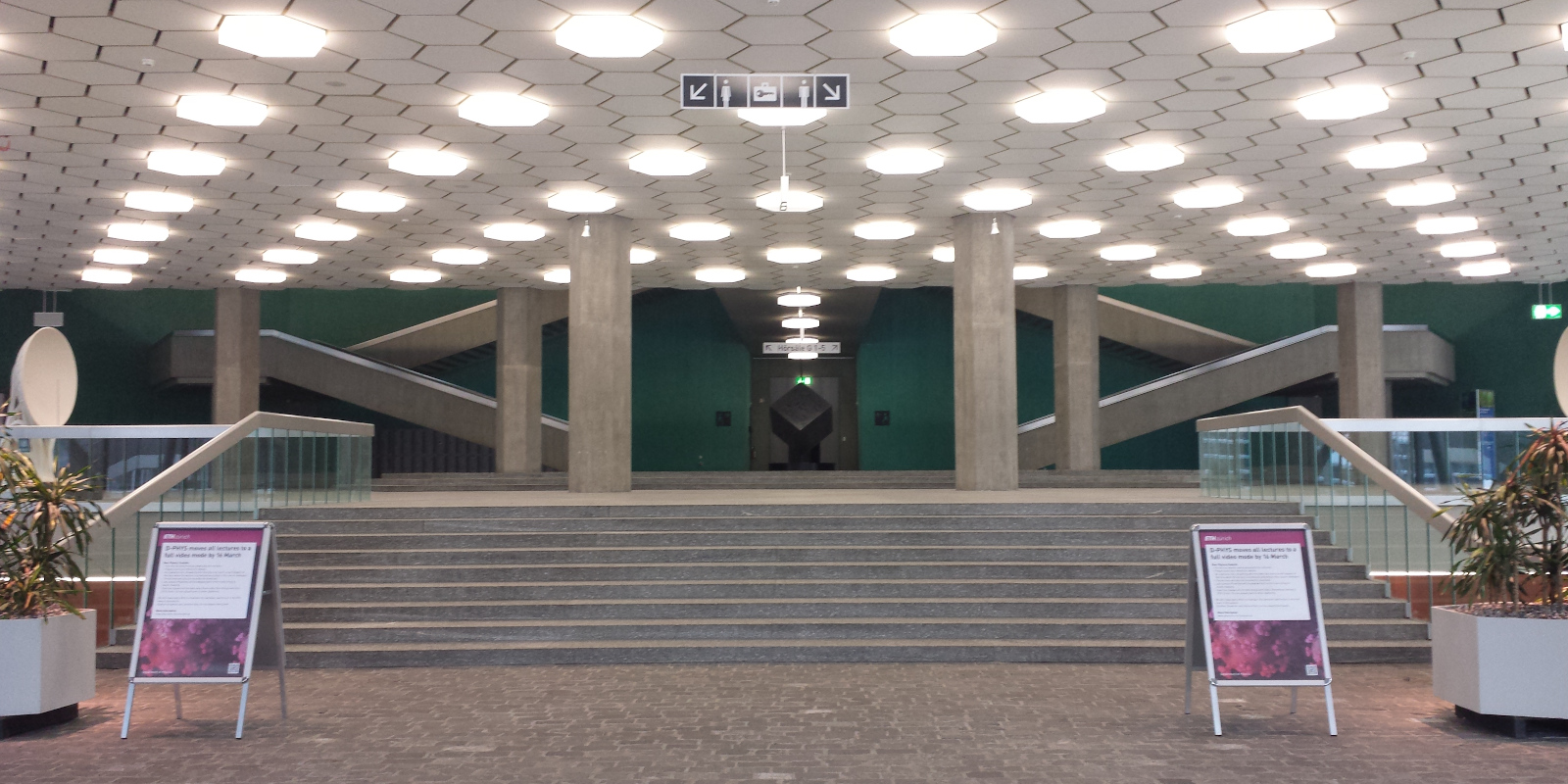
Manfred Sigrist, Professor of Theoretical Physics, has been lecturing at ETH Zurich since 1995. He regards the huge blackboards in the lecture halls as key teaching aids. How is he getting on, now that students have not been allowed on campus since 16 March?
Remarkably well, actually. “With a great deal of improvisational skill and hastily purchased equipment, we were able to make the lecture halls suitable for video streaming,” says Marius Simon from Teaching Services at the Department of Physics. The empty seats now accommodate cables and cameras. A fascinating combination of physical and virtual presence is emerging during the lectures. A camera shows the large blackboard, in front of which Sigrist stands alone, chalk in hand, addressing his virtual audience. For experimental physics, Simon's team still physically sets up the experiments in the lecture hall so they can be integrated seamlessly into the lecture.
The rapid switch
This requires unusual ideas. Depending on students’ bandwidth, the blackboards can appear pixelated, so Sigrist takes a photo during the break and uploads it to the Moodle learning platform before wiping the board for the second half. He answers any questions at the end of the lecture. To do so, he stands in front of his laptop where he can read his students’ electronic messages, unlike when he is at the blackboard. In the meantime, an assistant ensures that he is connected to the virtual world.
The practical courses also take place via the video conferencing tool. The teaching assistants do not work with blackboard and chalk, however, but use electronic pens and tablets instead. “It works surprisingly well. I’m amazed at how quickly ETH implemented the switch,” says junior mathematics assistant Anna Knörr, currently also working from home. “We use the tool’s joint whiteboard function for our practical courses, which is great when the internet connection is good. I encourage everyone to turn on their camera and ask questions orally.”
The search for a new normal
The students are very grateful for the swift response of both ETH and the department, particularly when they compare their situation to that of students in other countries. They find it interesting to see how differently the professors use the tools, with some even enjoying developing new methods. Knörr is confident that “an evaluation over the coming weeks is likely to offer great potential for optimising all of ETH.”
She continues, “The most frustrating moment in the last few days was when my internet connection crashed.” She is not the only one under pressure. Many colleagues are also struggling with network problems at their temporary workstations at home, located as far as possible from other family members. Although many things are running more smoothly in the second week of working from home, the initial enthusiasm for the novel situation is wearing thin and a certain fatigue has begun to show. The objective now is to bring the fast pace back down to normal levels and establish a sound structure for the new day-to-day routine.
Communication is key
When struggling with technical problems at home, it is all the more important to stay well informed. Communication is vital, therefore, not just at university level but also within the department. As well as publishing information on the coronavirus crisis in a prominent position on its website, the Department of Physics has set up a wiki to facilitate discussion between the teaching staff and researchers. Feedback has been very positive, meaning that the major effort has paid off.
The department’s IT Service Group had its own challenges to contend with, patiently helping with support to maintain the information flow in the new home office environment, ensuring that hardware was working and that the tools provided, some of which were new, could quickly be put to use. Solutions have also been found for informal networking: the Quantum Science and Technology lunch seminar is about to go online, which involves the approximately 30 participants eating together at their workstations. Some groups have already introduced virtual coffee breaks.
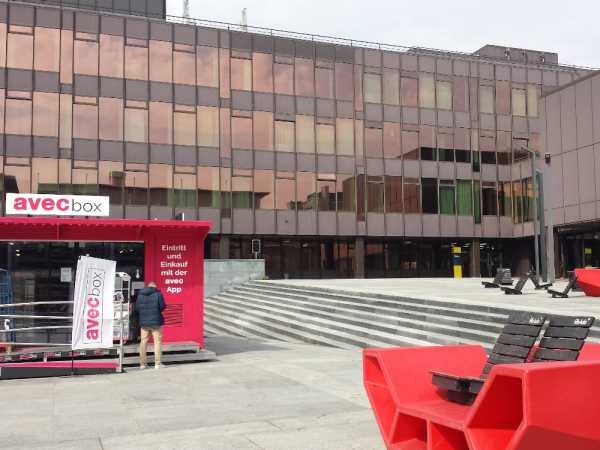
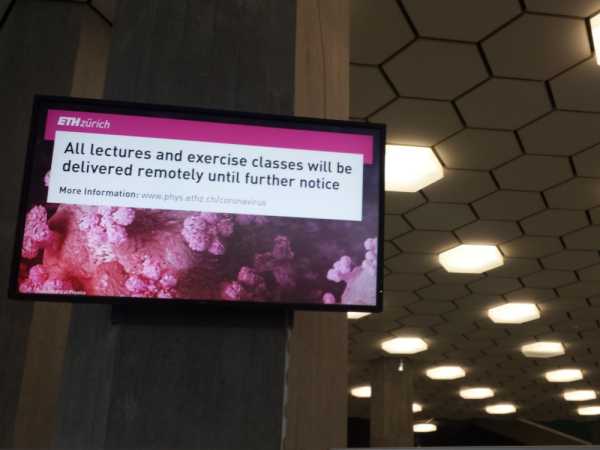
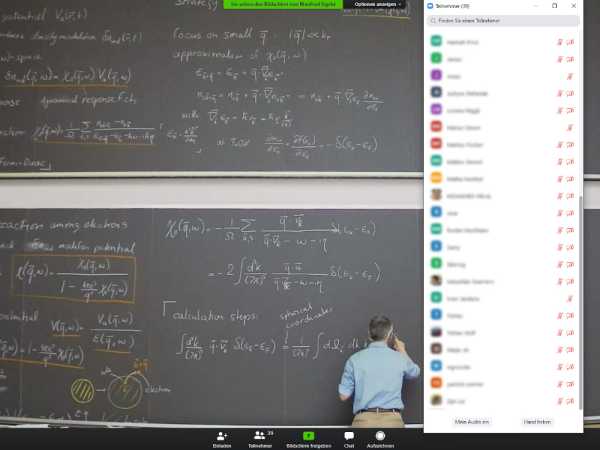
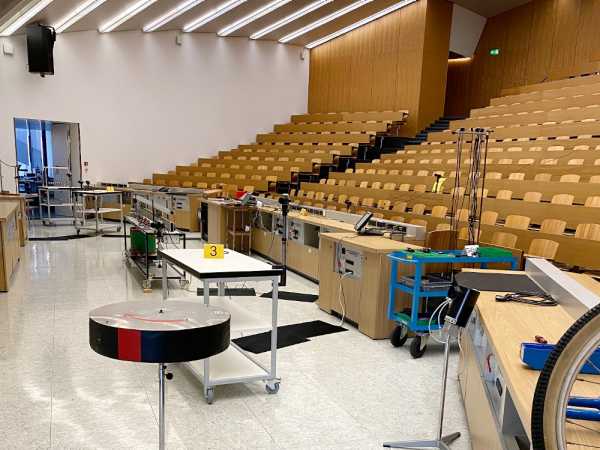
Practical course@Home
As regards practical courses, the department is striking out in new directions to ensure that courses can continue without interruption. Almost half of the 120 physics students took part in the first “Practical course@Home” on 23 March. Teaching Services are now working at full speed to develop new experiments that can be conducted at home. The goal is to offer students the best possible substitute for customary onsite practical experience.
Experiments that focus on data analysis are especially suitable for study from home. These experiments had already been planned before the lockdown and are now to be implemented without delay. Students can also easily carry out electronic experiments at home using simulation software. However, those in charge of the practical courses want to do more than just make measurement data available; they want to make the virtual hands-on exercises more exciting. The assistants are also contributing by suggesting ideas. Six to eight new experiments are now being developed that will enable students to use the sensors in their smartphones as measuring devices. At some point in the future, when things are back to normal, these experiments will be reused at busy times.
Five days instead of five years
Department coordinator Sebastian Huber, who has been in office for just three months, puts it in a nutshell: “We managed to introduce online teaching in five days. Under normal circumstances, this would have been a five-year project.” Seeing a complex organisation pooling its efforts, despite the emergency, to prevent students from losing the semester is also a huge motivation for him. “We have accelerated the decision-making process enormously - in the knowledge that our proactive behaviour has sometimes exposed us somewhat. But with a healthy error culture, we have found a good solution for most problems," Huber reports.
A new culture of error tolerance has taken root in these turbulent times, from which all parties will benefit in the future. After all, anyone embarking on a new venture must be allowed to make mistakes. An extreme scenario such as this suddenly opens up new horizons and eases existing structures. “Never in my wildest dreams would I have thought that the tough measures we have been forced to adopt would be received with such goodwill and energy or be accepted so readily,” says department head Jérôme Faist, continuing: “We can truly be proud of how our department is handling this crisis.”
Far-reaching consequences
Needless to say, there has also been some criticism. If they had had their way, not everyone in the department would have taken these drastic measures as proactively and systematically as those in charge did. Shutting down the department has far-reaching consequences for many. Research has come to a sudden standstill for the most part, regardless of what stage the measurements and experiments were at. This affects doctoral students in particular: they cannot continue with the experiments they have spent so much time preparing and, depending on the status of their work, will not be able to conclude them as planned. They now need solutions that are tailored to their particular situation.
The workshops are also closed. Their staff are at home and the 13 apprentices who are about to take their final examination have to interrupt their practical work. Nobody knows when the exams for the around fifty apprentices at ETH will take place.
Maintaining emergency service
Although most experimental research in the labs has currently been stopped to protect the staff, not all devices and experiments can simply be switched off. The expensive NMR devices that would be damaged without continuous cooling with liquefied gas are still running, for example. As the Department of Physics also supplies liquefied gases to other departments, an emergency service has been set up to safeguard valuable, long-term biological samples. A skeleton staff is now on duty on a rotating basis, ensuring that central tasks and backups can be performed in an emergency.
The crisis is also having unexpectedly positive effects. The refurbishment of the physics buildings and labs, which had been severely hampering research work to some extent since the beginning of the year, can now continue without restriction. Since only a small team of tradesmen can work throughout the entire building, it can meet the hygiene requirements. Provided construction work is still possible, the refurbishment can now be completed more quickly than originally planned.
Comments
Additional comments are available for the German version of this article. Show all comments
If we had Smart Boards, things would be easier. Expensive but effective!